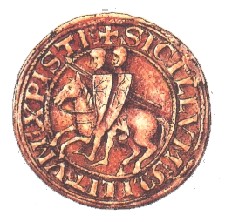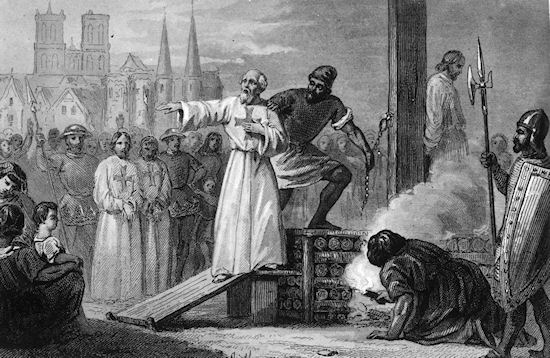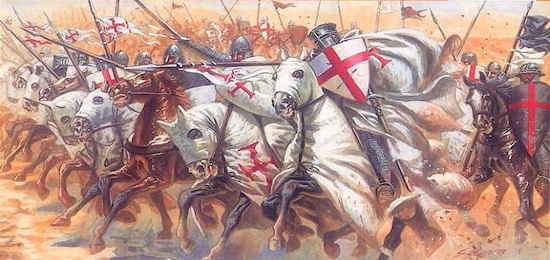The Order of the Knights of the Temple, or Templars as they went down in history, was for almost 200 years one of the most important military and economic forces of its time.
A turbulent and dark era that to this day gives rise to stories, myths, and even modern conspiracy theories. The Templars were soldiers, monks, bankers and perhaps guardians of some great, dangerous secret, which eventually caused their downfall.
History
In 1118 in Jerusalem, right after the 1st crusade, the French knight Hugues de Payens and 8 of his companions took vows of penance and loyalty to Christ, founding the first knightly-monastic order with the name "poor knights of Christ and the Temple". The King of Jerusalem Baldwin II supported them materially and financially and granted them a place to stay, in exchange for the protection of the pilgrims of the Holy Land. The accommodation they were given was on the site where Solomon's Temple was believed to have once been built. From there they got the name with which they stayed in history.
Ten years later, in 1128 in Troyes, France, the basic rules of the order, based on those of the Cistercian monks, were formulated. The only authority to which they were subject was the Pope himself, while the Grand Master of the order had full and absolute authority over the members. Their lifestyle was a combination of monastic life and harsh military discipline. Each new member of the order was required to renounce all personal property and power and devote himself completely and exclusively to it. For his introduction into the ranks of the Templars he had to go through an initiation process about which almost nothing is known, although speculation abounds. It is considered certain that this process included a series of physical and mental tests that would select those worthy of inclusion and prepare them for the hard life that would follow.
Their explosive growth in power and influence is probably due to a combination of factors. Their complete independence from all authority but that of the Papal throne was certainly one of them. Their centralized form of operation and the absolute authority of the Grand Master is another. The socio-political environment of the time a third. The Templars managed to become a military and economic force far stronger than most kingdoms of the time. Their military strength was mainly the result of their hard training and discipline. Their numbers were never particularly impressive, as the total number of knights, followers and priests of the order never exceeded 20,000, while no battle saw more than 1,000 Templars line up.
Their economic power was impressive. It seems strange how it is possible for a group of people who have taken vows of poverty to have managed to amass such financial resources. The answer seems to be quite complex. The members, taking an oath of penance, relinquished all their possessions to the order. Considering how many of the knights were previously nobles and owners of sometimes considerable estates, one stream of income is identified. But the real source of their wealth was the implementation of the first organized form of providing banking services.
Pilgrims visiting the Holy Lands could deposit money or other valuables at a Templar outpost, receiving a letter of credit which could be redeemed at another outpost, usually minus a fee for services rendered. In that way the pilgrims could travel in the region without the risk of losing all their valuables to roaming bandits. But very often they lost their lives, and the money and other valuables were left piling in the Templar warehouses.
The order also provided loan services to nobles in financial difficulty, even to kings, receiving land in return or charging interest to repay the capital. Without exception, all the chivalric orders of the time acquired wealth and power, but none as much as the "poor knights of Christ and the Temple". The Templars laid the foundations of the modern banking system.
But the combination of military power, wealth, and full autonomy, seems to have been the main cause that led to the events of their final days.
 |
After the loss of the Holy Land the Templars moved to Europe and although they spread to several countries most of them settled in France. On October 13, 1307 (according to the tale, the superstition concerning Friday the 13th has its roots in this event), by order of King Philip of France, all the Templars of France were arrested, including Grand Master Jacques de Molay. It was a well-organized operation which managed to surprise the Templars. The charges were religious in nature and focused on the content of the secret initiation ceremonies of the members of the order. The Templars were accused of being heretics, pagans and homosexuals and handed over to the Inquisition. The inquisitors, using torture, managed to extract confessions from several members of the order. It should be noted that the method of extracting confessions by the method of torture was a basic principle of the legal system of the time, as it was the only way to substantiate an accusation, in the absence of eyewitnesses.
The first reaction of the then Pope, Clement V, was rather angry, as he was the only one who had the right to exercise control over the order. But the first confessions had already emerged. At this point there is a difference of opinion among many historians as to whether Philip and Clement planned the persecution together. It seems more likely, however, that Philip initiated the persecution on his own initiative and any agreements were made afterwards. In 1308, the investigation of the accusations by the Papal commissions began and the arrests and interrogations extended outside France, to all places where there were Templars. In most of the other countries (England, Spain, Germany) the knights of the order were declared innocent, with the exception of isolated individual cases. But in France the case had been decided. Those members of the order who had confessed were imprisoned, and their punishments included systematic indoctrination to bring them back to the right path. Those who retracted their confessions, a total of 54 members of the order, were considered unrepentant heretics and were burned at the stake on May 12, 1310, in Paris.
On 16 October 1311, the Council of Vienna which held a comprehensive examination of the order's actions decided that it could not be proven that the order, as an organized body, had adopted heretical views and practices and that any confessions made, only concerned the individuals involved. Subsequently, it was proposed, by a majority, not to disband the battalion. But the Pope, apparently pressured by the King of France, decided to dissolve the order on March 22, 1312, but without condemning it.
The property of the Knights was either confiscated or transferred to the Knights Hospitaller, while the members of the order in countries other than France, either joined other chivalric orders, or followed the monastic life. Still pending was the fate of Grand Master Jacques de Molay and his three lieutenants. They had confessed their guilt and had to return to the right faith. But during the public ceremony for the announcement of their sentence outside Notre Dame in Paris, Jacques de Molay retracted his confession and proclaimed both his own innocence and the unjust and false accusations against the entire order . After this recantation of his confession, in which he was followed by one of his lieutenants, he was led to the pyre, on March 19, 1314. According to legend, Jacques de Molay, through the pyre, cursed the Pope and its King of France to appear before God's judgment seat before time runs out. Both died shortly afterwards.
 |
The issue of the Templars' guilt and the veracity of the accusations against them, divides historians and scholars to this day. There are not a few who argue that it is very likely that several elements of oriental mysticism were included in the initiation ceremonies, as a result of the interaction with the peoples of the Eastern Mediterranean and their rivals in the Holy Land. To what extent and in what form remains unknown, as little is known about the exact rituals.
Modern organizations, most of them founded in the 19th century, that claim the title of authentic continuation of the tradition of the order are numerous and cover a wide range, from simple social groups to sections of Freemasons.
Speculation
The history of the Knights Templar, and especially the way in which the order was terminated, has given rise to a number of theories. According to these theories, the power and influence of the Templars must have been due to some other factor besides those already mentioned. One of these theories holds that the Templars, during their encampment at the site of Solomon's Temple, managed to discover the Ark of the Covenant, in a crypt, underground. The Ark was the "treasure" of the Templars that is often mentioned in various texts of the time, as well as historical books written about the order. The possession of this relic was also the real source of their power, as they possessed the "Word of God" itself. After the departure from the Holy Land, the Ark was kept in Paris and evacuated only at the last moment before their arrest by King Philip, in an unknown direction. Philip and the Pope actually sought to have the Ark removed from the Templars, and the tortures that followed the arrests were intended to reveal where the Ark was being transported. But they never managed to find out, and the Ark remains to this day either forgotten in the place where it was taken after Paris, or under the protection of a branch of the Templars that has remained active all these years, with the sole mission of guarding the holy relic .
Another theory replaces the Ark with the Holy Grail, while a third theory, perhaps the most compelling of all, designates the Templars the holders and custodians of a shocking secret. According to one version, this secret was passed on to them and perhaps its protection was also the main reason for the establishment of the order, while according to another, it came into their possession through the discovery of ancient texts when they were in Jerusalem. This theory is based on various reports of the so-called Gnostic or Apocryphal Gospels of the New Testament (texts which for various reasons were not included in the canon of the New Testament) and mainly that of Philip. According to this theory, Christ and Mary Magdalene were actually married. This view has been expressed several times, but this particular theory goes one step further.
According to the canon of the New Testament, after the death of Christ, Mary Magdalene withdrew from worldly life, becoming an ascetic in a cave, where she remained until her death. But this theory supports that at the time of Christ's crucifixion Mary was pregnant and afterwards left Palestine and traveled to Gaul, where she eventually gave birth to Sarah. The first Kings of France, the Merovingian dynasty, are said to be direct descendants of Christ and Mary. They remained in power from the 5th to the middle of the 8th century AD, when they gave way to the Carolidian dynasty. But the Merovingian bloodline was preserved. The Templars were protectors of the bloodline of Christ, the descendants of the Merovingians and custodians of the secret, possessing ancient texts that proved it, in a more concise way than the Gnostic Gospels.
The operation to dissolve the Templars was organized by those two powers who were threatened by the secret. The secular authority of the King of France who would probably be threatened by a descendant of the Merovingians and the spiritual authority of the Pope as the very basis of religious doctrine was in question. The torture was intended to reveal both the identity of the descendants of Christ and the Merovingians, as well as the texts that contained the evidence. The theory further claims that both Templar secrets remained safe, in the custody of some branch of the order that continued to exist, with far fewer members and never manifesting its existence. The two secrets still exist today. Direct descendants of Christ live somewhere among us and in some crypt the ancient texts that record the unknown history of the Son of God are hidden.
The name of the Templars has also been involved in the case of the famous Shroud of Turin, the piece of cloth which is said to be the shroud of Christ. According to one version, the Shroud came into the hands of the Templars during the conquest of Constantinople by the crusaders in 1204, in which the order also participated. It is said that the first public appearance of the Shroud took place in 1357, when the family of Geoffrey de Charney, the knight who was burned with de Molay in Paris, exhibited it to the public for pilgrimage. Three independent academic institutions, overseen by the Catholic Church, performed C-14 dating examination of the relic in the late 1980s, and all indicated the late 13th century AD, leading some to the rather arbitrary hypothesis, that the man whose features have been imprinted on the Shroud is none other than de Molay, at the time of his torture by the inquisitors.
Epilogue
The monastic-chivalric orders of the period usually bring to mind images of gatherings and secret ceremonies in torch-lit, stone halls of castles, where Christian ritual is mixed with satanic symbols and pagan remnants. Perhaps the accusations against the Templars have been etched into our collective consciousness and are surfacing this way. Our imagination is also attracted by the secret ancient texts that may be hidden in monastery libraries, containing secrets that may change the image we have of our world. Is this again the product of a collective subconscious memory?
As much as the theory of the "bloodline of Christ" arouses interest and comes to complement the above representations in an almost ideal way, it is obvious that it has major holes. For example, the connection of the descendants of Christ with the Merovingian dynasty is made without any actual data.
At the same time, the recorded history of the persecution of the Templars refers more to a struggle for power and money. Why try to explain their persecution through the various theories that they possessed some important, mythical relic, or a terrifying secret and not accept the obvious? That their power, combined with their autonomy, was no longer tolerated by the state power of the country in which they had their headquarters, and which at that time exercised a strong influence on the spiritual authority which alone was competent to judge and break them up.
However, the fascination exerted by the possibility of the existence of some great secret, some unknown history at the foundations of Christianity, or of human history, is undeniable. Is it simply the manifestation of the exploratory nature of man, the need for knowledge, or in some strange way we know that there are some lost pieces of our history and we await their revelation.





